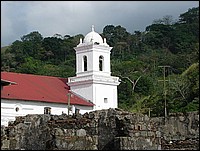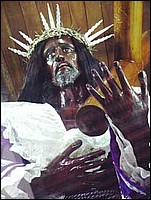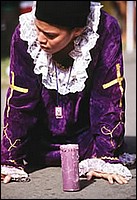
Festival of Black Christ
Black Christ Church, Portobelo
 The large white church at Portobelo is the Iglesia de San Felipe, which is still in use. It dates from 1814, but its tower wasn’t completed until 1945. It’s famous as the home of the life-sized effigy of the Nazareno of Portobelo, better known as the Black Christ. The effigy, depicting Christ carrying the cross, normally resides on a podium to the left of the altar, but it is brought out to the center of the church for the Black Christ Festival, by far Portobelo’s biggest event. The handsome altar of the church is adorned with gold images depicting various emblems of the crucifixion, including nails, instruments of torture, and the dice the Roman soldiers cast for Christ’s robe. Small wooden carvings ringing the walls depict the stages of the cross.
The large white church at Portobelo is the Iglesia de San Felipe, which is still in use. It dates from 1814, but its tower wasn’t completed until 1945. It’s famous as the home of the life-sized effigy of the Nazareno of Portobelo, better known as the Black Christ. The effigy, depicting Christ carrying the cross, normally resides on a podium to the left of the altar, but it is brought out to the center of the church for the Black Christ Festival, by far Portobelo’s biggest event. The handsome altar of the church is adorned with gold images depicting various emblems of the crucifixion, including nails, instruments of torture, and the dice the Roman soldiers cast for Christ’s robe. Small wooden carvings ringing the walls depict the stages of the cross.
Behind this church is the recently renovated Iglesia de San Juan de Dios, home to the new Museo del Cristo Negro de Portobelo, which now displays 63 of the robes donated by Panamanians for the festival, some of which are more than 100 years old. Among the more famous is the one donated by the champion boxer Roberto “Manos de Piedra” (hands of stone) Duran.
 The Black Christ figurine’s robes are changed twice a year, and each is used just once. The statue is adorned with a red wine–colored robe for the Black Christ Festival held each October 21. This is changed to a purple one for Holy Week. Many of the robes are donated anonymously. Some are simple and others are quite ornate, done up in gold trim and the like. The priciest one on display here cost the donor an estimated $1,700 for the raw materials alone.
The Black Christ figurine’s robes are changed twice a year, and each is used just once. The statue is adorned with a red wine–colored robe for the Black Christ Festival held each October 21. This is changed to a purple one for Holy Week. Many of the robes are donated anonymously. Some are simple and others are quite ornate, done up in gold trim and the like. The priciest one on display here cost the donor an estimated $1,700 for the raw materials alone.
Since the 17th century, Portobelo has been the home of the Cristo Negro de Portobelo - the Black Christ of Portobelo. There are several explanations for the presence of this life size figure of a black Christ in the village. Each story has three parts - the arrival of the statue, the refusal of the statue to leave the village, and its veneration. Regardless of the version, however, all of the stories conclude that the statue is responsible for miraculous deeds in the lives of his devotees.
Nobody knows exactly how or when the Black Christ (El Cristo Negro) arrived in the tiny community of Portobelo on Panama’s Caribbean coast. Some put the date at around 1658. But there are so many stories of miracles associated with the Black Christ, that tens of thousands of pilgrims visit the Church every October 21.
 Some walk the 53 miles from Panama City, thousands walk the last 22 miles from Sabanitas, and many crawl the last mile on hands and knees to worship before El Nazareno, one of the names given to the Black Christ by locals. Many wear ornate purple robes that are discarded at midnight on the steps of the church in which the statue is now housed, Iglesia San Felipe. The robes announce that the wearer is responding to a divine command, doing penance for wrongdoing, or simply making an expression of faith.
Some walk the 53 miles from Panama City, thousands walk the last 22 miles from Sabanitas, and many crawl the last mile on hands and knees to worship before El Nazareno, one of the names given to the Black Christ by locals. Many wear ornate purple robes that are discarded at midnight on the steps of the church in which the statue is now housed, Iglesia San Felipe. The robes announce that the wearer is responding to a divine command, doing penance for wrongdoing, or simply making an expression of faith.
There are several explanations for the presence of this life size figure of a black Christ in the village. Each story has three parts - the arrival of the statue, the refusal of the statue to leave the village, and its veneration. Regardless of the version, however, all of the stories conclude that the statue is responsible for miraculous deeds in the lives of his devotees.
At the time the Cristo Negro arrived in Panama, there was a plague on the coast that was devastating the population. The people of Portobelo began to venerate the figure of the black Christ and "miraculously" the plague ended. By some accounts, the plague avoided Portobelo but continued in other areas. As rumor spread among the slaves, freed blacks, mulattos, and criollos, people began arriving in Portobelo to venerate the figure. The first pilgrims began arriving from surrounding villages on the coast, but shortly after, they began arriving from Panama City on the Pacific side of the country. These pilgrims had to cross the isthmus over mountains and through a dense and dangerous rainforest.
Since then, each year for the last three centuries on the 21st of October the Feast Day of the Cristo Negro de Portobelo, as many as 60,000 devotees make a pilgrimage to visit the statue. Some walk as many as 200 kilometers from their homes in the interior of the country to get to the village, while others come from the United States, Europe and other parts of Latin America. Among them are thousands of muggers, burglars and drug dealers, seeking forgiveness from the Black Christ for their crimes. Wrongdoers line up at the San Felipe church to pay homage to the Black Christ statue. Many in Panama regard the Black Christ as the Patron Saint of criminals.
Many stories surround the Black Christ statue’s arrival in this unlikely place. All agree that it was carved in Spain, arrived on a ship and was washed ashore at Portobelo. The rest is shrouded in the mists of time and myth.
One story holds that the ship carrying the heavy statue in a wooden crate met a terrible storm that drove it back into the harbor. The ship attempted to leave five times, but every time a sudden and unexpected storm endangered the ship and everyone aboard. On the final attempt, the crew jettisoned the crated Black Christ to lessen the weight and save their lives.
Fishermen, amazed by the lack of respect shown by the sailors, carried the Black Christ to their church and gave it a place of honor.
Another myth is that the figure Jesus of Nazareth was destined for the island of Taboga, off the Panamanian coast, but the Spanish shipper incorrectly labeled the shipment. Many attempts were made to send the statue to Taboga, but all attempts to remove it from Portobelo failed. The people of Portobelo, who suspected the figure had magical powers, said it wished to remain with them.
The sick, the troubled and the needy pray before the ornately robed statue of the Black Christ for the miracles they hope to receive, but it is said that if a promise is made and not kept there will be severe retribution.
The popular name, The Black Christ, is attributed to U.S. servicemen shortly after the Second World War. Some 500 arrived in a ship to celebrate the October festival. One witness of that particular day says that many of the U.S. visitors were so caught up in the emotional fervor that they began to shout “Viva El Cristo Negro!” The name stuck everywhere except in Portobelo. A more familiar name is simply The Saint.
Mass is called at 6 p.m. on October 21. (Be there before 4 p.m. if you hope to get inside the church.) At exactly 8 p.m., 80 able-bodied men carry the statue from the church to begin a four-hour parade around the community. There is a carnival atmosphere.
The bearers take three steps forward, two back, in a similar manner to that of Spanish religious processions. But, unlike those of Spain, this procession has a special Latin American twist: a quick step to lively music. The bearers have freshly shaved heads, wear purple robes and have bare feet. It is a distinct honor to be chosen to bear the Black Christ, an honor paid for by sore shoulders and aching muscles the next day.
At exactly midnight, The Saint is returned to the church. One story holds that it is impossible to return the Black Crist before midnight. “It just gets too heavy to move.”
For a good choice of hotels with discount prices, click on the link below:
Hotels in Panama City

